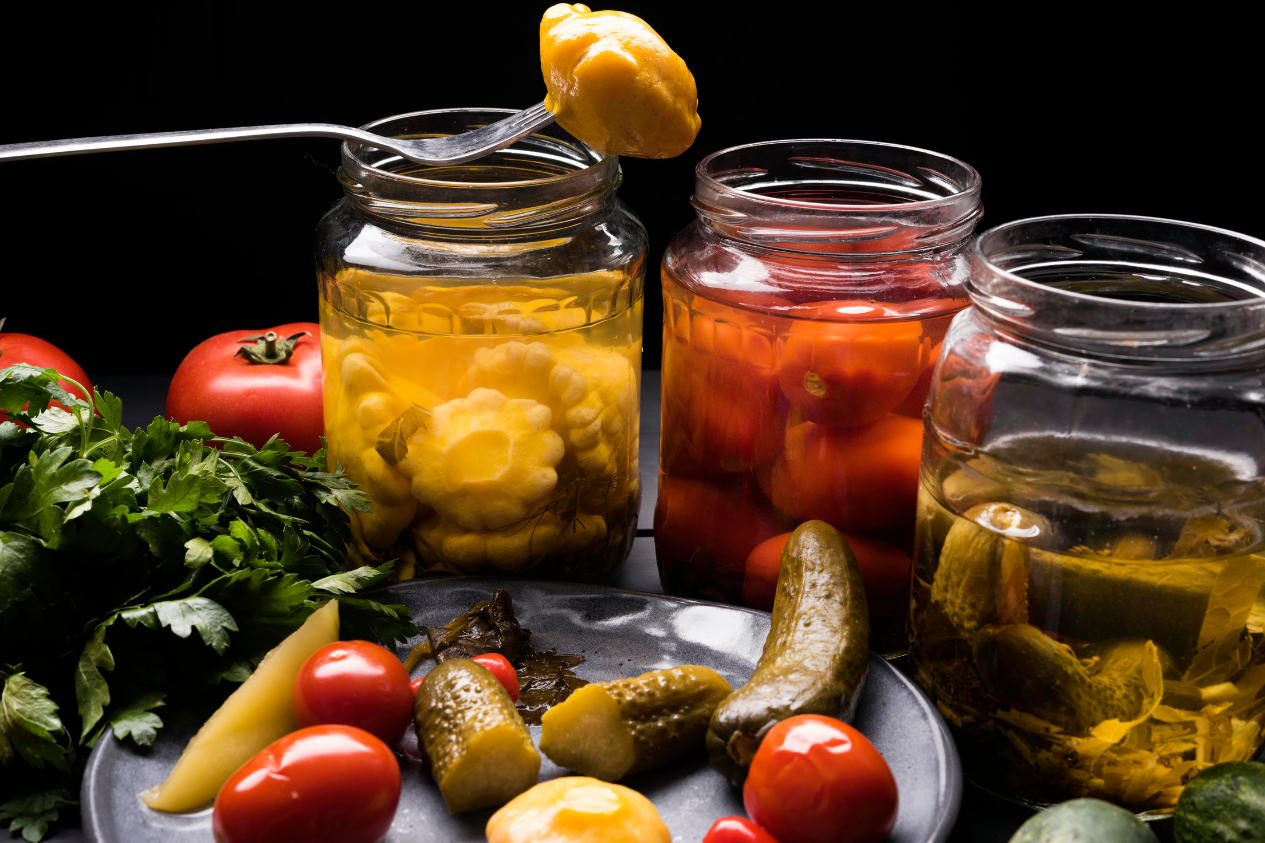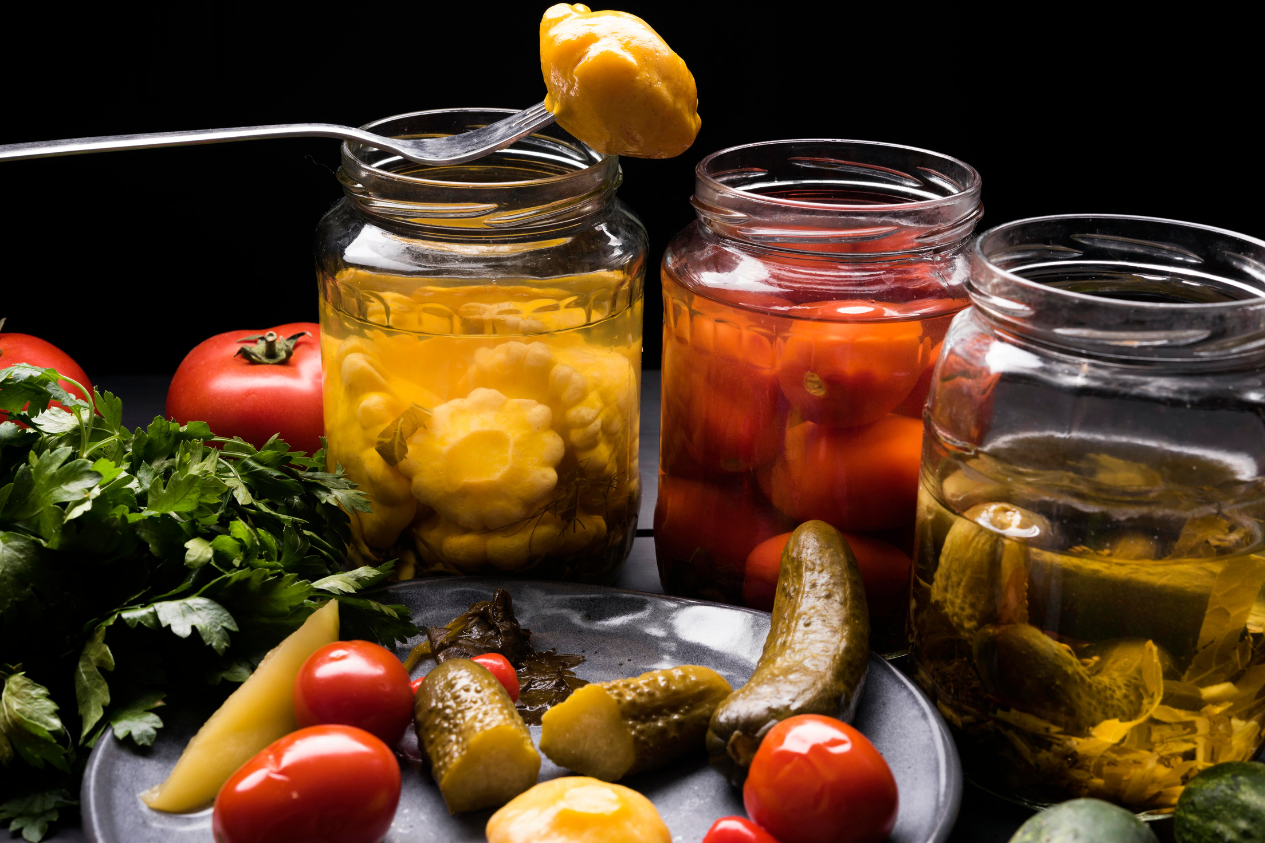
The Science of Ferment: Easy Homemade Fermented Foods

Observing life develop in a jar has a certain allure. What was once commonplace—fruit, dough, milk, or cabbage—becomes intricate, colorful, and incredibly nourishing as tiny bubbles form and tangy scents blossom. This is the science of ferment, an ancient alchemy in which microorganisms work alongside us in the kitchen.
Fermentation is a living process, not just a cooking method. In order to preserve food while improving flavor and nutrition, it depends on helpful bacteria and yeasts that transform sugars into acids, gases, and alcohol. These simple changes, which can be found in everything from kimchi to kefir, sauerkraut to sourdough, simultaneously unlock taste, health, and history.
These 10 simple homemade fermented foods will help you incorporate the age-old science of fermentation into your contemporary cooking.
1. Sauerkraut
Ingredients for Sauerkraut
- 1 medium green cabbage (about 1 kg)
- 1 tbsp sea salt (non-iodized)
- Optional: 1 tsp caraway seeds or juniper berries
Method for Sauerkraut
- Slice the cabbage thinly and place it in a large bowl.
- Sprinkle the salt over and massage for 10–15 minutes until liquid releases.
- Pack the cabbage tightly into a sterilized jar, ensuring the brine covers it.
- Weight it down and cover loosely.
- Ferment the sauerkraut for 1–4 weeks, tasting as you go until it’s perfectly tangy.
Sauerkraut is the ultimate beginner ferment — crunchy, sour, and full of probiotics that support digestion.
2. Classic Dill Pickles
Ingredients for Dill Pickles
- 6–8 small cucumbers
- 4 cups water
- 3 tbsp sea salt
- 1 tbsp mustard seeds
- 3–4 cloves garlic
- 2–3 fresh dill sprigs
Method for Dill Pickles
- Dissolve salt in water to make a brine.
- Pack cucumbers, garlic, dill, and mustard seeds into a jar.
- Pour brine over, leaving an inch of headspace.
- Cover and ferment the dill pickles at room temperature for 5–7 days.
Your classic dill pickles will bubble and cloud as lactic acid forms — a sure sign of good bacteria at work.
3. Kimchi
Ingredients for Kimchi
- 1 Napa cabbage
- 1/4 cup sea salt
- 4 garlic cloves
- 1 thumb-sized piece of ginger
- 1 tbsp sugar
- 3 tbsp Korean chili flakes (gochugaru)
- 2 spring onions
- 1 carrot, julienned
- 2 tbsp fish sauce (optional)
Method for Kimchi
- Chop the cabbage and soak it in salted water for 2 hours.
- Rinse, then mix with garlic, ginger, chili, and vegetables.
- Pack tightly into jars, pressing down to release juices.
- Let kimchi ferment for 3–5 days, then refrigerate.
Fiery, funky, and full of umami — kimchi is both a condiment and a celebration of controlled chaos in a jar.
4. Fermented Garlic Honey
Ingredients for Fermented Garlic Honey
- 1 cup raw honey
- 10–12 garlic cloves, peeled
Method for Fermented Garlic Honey
- Place garlic cloves in a jar.
- Pour honey over to submerge completely.
- Loosely cover and stir daily for the first week.
- Let the fermented garlic honey sit for 2–4 weeks until bubbles form.
Use fermented garlic honey for immunity shots, drizzles over cheese, or as a sore-throat remedy — nature’s antibiotic with a golden glow.
5. Sourdough Starter
Ingredients for Sourdough Starter
- 1/2 cup whole wheat flour
- 1/2 cup filtered water
Method for Sourdough Starter
- Mix flour and water in a jar.
- Cover loosely and keep at room temperature.
- Feed your sourdough starter daily with equal parts flour and water.
- After 5–7 days, it should bubble and double in size — ready to bake.
The sourdough starter is a living culture that embodies patience and rhythm. It becomes the heart of every beautiful loaf you’ll bake.
6. Homemade Yogurt
Ingredients for Homemade Yogurt
- 1 liter full-fat milk
- 2 tbsp plain yogurt (with live cultures)
Method for Homemade Yogurt
- Heat milk to just below boiling, then cool to 45°C.
- Stir in yogurt starter.
- Pour into a container, cover, and keep warm for 6–8 hours.
- Chill before serving.
Homemade yogurt is one of the simplest ferments — creamy, probiotic-rich, and endlessly versatile for breakfast bowls or marinades.
7. Ginger Bug
Ingredients for Ginger Bug
- 2 tbsp grated fresh ginger
- 2 tbsp sugar
- 2 cups water
Method for Ginger Bug
- Mix ginger, sugar, and water in a jar.
- Cover with a cloth and stir daily, feeding more ginger and sugar for 3–5 days.
- When bubbly, your ginger bug is alive and ready to start sodas or kombucha.
The ginger bug is your starter culture for natural fizz — a tiny microbial engine that powers homemade fermented drinks.
8. Fermented Red Onions
Ingredients for Fermented Red Onions
- 2 red onions, thinly sliced
- 2 cups water
- 1 tbsp sea salt
Method for Fermented Red Onions
- Dissolve salt in water to create brine.
- Pack onions into a jar and cover with brine.
- Ferment for 3–5 days, then refrigerate.
Fermented red onions add a gentle tang and pop of color to tacos, salads, or grain bowls — proof that beauty and bacteria can coexist deliciously.
9. Kombucha
Ingredients for Kombucha
- 4 black tea bags
- 1/2 cup sugar
- 1 SCOBY (symbiotic culture of bacteria and yeast)
- 4 cups water
Method for Kombucha
- Brew tea with sugar and let it cool.
- Add the SCOBY and 1 cup of previously brewed kombucha (as starter).
- Cover and let ferment 7–10 days.
- Strain and bottle; for flavor, add fruit juice for a second fermentation.
Fizzing and tart, kombucha is tea transformed — alive with probiotics, a natural energy drink from the microbial world.
10. Fermented Sweet Potato Miso
Ingredients for Fermented Sweet Potato Miso
- 2 cups cooked mashed sweet potatoes
- 1 cup koji (rice inoculated with Aspergillus oryzae)
- 2 tbsp salt
Method for Fermented Sweet Potato Miso
- Mix all ingredients until smooth.
- Pack into an airtight jar, leaving space for gases.
- Let the fermented sweet potato miso age for at least 2 months.
Earthy, slightly sweet, and full of umami, sweet potato miso shows how versatile fermentation can be — beyond pickles and drinks, it ventures into deep flavor chemistry.
Why Ferment at Home?
You can establish a primal connection with your food through homemade fermentation. Because it uses less packaging and waste, it is environmentally friendly. It's cost-effective and transforms basic veggies into gourmet mainstays. It's a slow process in a fast-paced world, but it's incredibly fulfilling.
Beyond flavor, fermented foods improve immunity and mental health by fortifying your gut microbiota. What our ancestors instinctively knew—that healthy microbes translate into a healthy life—is finally being recognized by modern science.
Download Foodism today and share your version of fermented foods!




